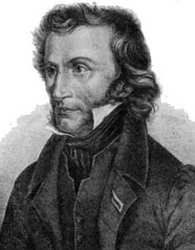Playing with a skill so dazzling and in so eerie a manner that it was seen as supernatural, violinist and composer Niccolò Paganini is considered to be one of the greatest violin virtuosos of all time.
Niccolo Paaganini’s Early Days
Niccolò Paganini was born on October 27, 1782, in Genoa, Italy. Paganini’s father was an amateur mandolin player who began teaching Paganini to play the violin at age seven. After giving his first public performance when he was just 11 years old, Paganini went through a succession of teachers, all of whose abilities he quickly surpassed. As a teenager, Paganini continued teaching himself the violin and practicing obsessively, often up to 15 hours a day. In 1797, the 15-year-old Paganini embarked on his first tour of Italy.
As a teenager, Paganini’s budding fame led him to be lured by the temptations of drinking and gambling. It was around this time that Paganini became the lover of an unknown wealthy woman from Florence who took him to live with her at her estate. While there, he did not perform publicly; instead, he focused on his playing and working on compositions for the violin and guitar. In 1805, when he was 25 years old, Paganini reentered the public sphere as the musical director for the orchestra of the Princess of Lucca, Napoleon’s sister.
Sources in this Story
- Life in Italy: Niccolo Paganini
- The Violin Site: Niccolo Paganini
- Britannica Online: Niccolò Paganini
- Thirteen/WNET (Baker’s Biographical Dictionary of Musicians): Niccolò Paganini
- Allmusic: Niccolò Paganini
Paganini’s Notable Accomplishments
Paganini wrote 24 caprices for solo violin that demonstrated Paganini’s unique violin techniques and established his reputation as one of the first true violin virtuosos. In Italy, he reached celebrity status after a series of successful concerts in 1813 in Milan.
In 1824, Paganini began a romantic relationship with Italian singer Antonia Bianchi, with whom he had a son, Achilles. Pope Leo XII knighted the violinist in 1827.
Paganini’s success took on international status after a European tour that included hugely successful concerts in Vienna, Paris and London. Paganini’s violin techniques were so radical that, in 1829, they spurred a German violinist to document the innovations. His performances so thrilled and astounded audiences, he earned the nickname Hexensohn, or “witch’s brat”; he cultivated this persona by wearing all black, arriving at concerts in a black carriage pulled by four black horses and swaying back and forth in an unsettling manner while playing.
The Man and his Work
- “Paganini: 24 Caprices” (James Ehnes)
- “Paganini: Violin Concertos” (Salvatore Accardo)
- “Paganini: Music for Violin and Guitar I” (Scott St. John and Simon Wynberg)
The Rest of the Story
In 1834, after much rigorous touring and resulting success, Paganini’s health began to fail. He spent most of his remaining years at his villa in Parma where his poor health kept him from playing more than a few concerts a year. He lost his voice in 1838 as a result of cancer of the larynx. On May 27, 1840, Paganini died in Nice, France.
Despite his short career, Paganini’s influence on classical music is far reaching; his approach to technical violin playing helped define classical virtuosity as it exists today. In his own time, Paganini’s violin work had a great influence on pianist Franz Liszt, whose attempts to recreate Paganini’s style on the piano led to important innovations.
This article was originally written by Caleb March; it was updated October 24, 2017.











